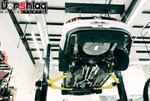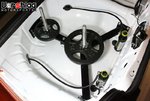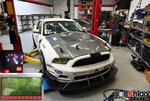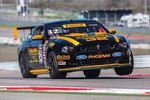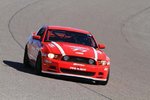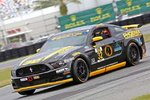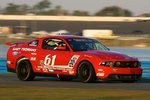http://racingcardynamics.com/weight-transfer/
You ever read this info? I really appreciated the exact math calculations of his work. Not that I can follow them totally! Lol Have a look, it's very educational. Long story short, he agrees with me on how you reduce that load on the front tires. Changes in CG are a last ditch effort and would be on a very dynamically odd racecar. Obviously he adds in the importance of anti roll bars as well which I would agree on too but maybe you would not.
If just moving weight to the rear of a nose heavy car was always the fix, why are there not multiple vendors selling the $1000 rear ballast kit for our mustangs? You could calculate the exact amount you would need and make a nice kit that fits in the spare tire well and give your car the perfect 50 50 weight distribution and the guarantee that you lap times will drop by seconds! Maybe that's the next million $ idea! Lol. Kidding but seriously there is a reason we have so many tools to alter how the chassis perform on track and allow adjustability for driver technique, track design, tire grip differences, engine power output , weight distribution etc etc. Assuming this guys lower control arms are aligned properly, a torque arm and proper sway bar adjustment would allow him to get around that track faster that ballast alone would. On top of that the car would brake better accelerate better and be under better control over all due the the improved rear grip and chassis dynamics.
That's about all I have to contribute on the subject. I agree, the lateral acceleration is why the car loads up the outside tires, not body roll alone. What im saying is the torque arm will transfer that load to the rear tires despite the car being nose heavy resulting in a more balanced car. Add in proper sway bars to load the inside tires as well as balance out the overseer condition a nose heavy car can have , and we have a very balanced (nose heavy) car thru the corner.
Sent from my LG-H932 using Tapatalk
You ever read this info? I really appreciated the exact math calculations of his work. Not that I can follow them totally! Lol Have a look, it's very educational. Long story short, he agrees with me on how you reduce that load on the front tires. Changes in CG are a last ditch effort and would be on a very dynamically odd racecar. Obviously he adds in the importance of anti roll bars as well which I would agree on too but maybe you would not.
If just moving weight to the rear of a nose heavy car was always the fix, why are there not multiple vendors selling the $1000 rear ballast kit for our mustangs? You could calculate the exact amount you would need and make a nice kit that fits in the spare tire well and give your car the perfect 50 50 weight distribution and the guarantee that you lap times will drop by seconds! Maybe that's the next million $ idea! Lol. Kidding but seriously there is a reason we have so many tools to alter how the chassis perform on track and allow adjustability for driver technique, track design, tire grip differences, engine power output , weight distribution etc etc. Assuming this guys lower control arms are aligned properly, a torque arm and proper sway bar adjustment would allow him to get around that track faster that ballast alone would. On top of that the car would brake better accelerate better and be under better control over all due the the improved rear grip and chassis dynamics.
That's about all I have to contribute on the subject. I agree, the lateral acceleration is why the car loads up the outside tires, not body roll alone. What im saying is the torque arm will transfer that load to the rear tires despite the car being nose heavy resulting in a more balanced car. Add in proper sway bars to load the inside tires as well as balance out the overseer condition a nose heavy car can have , and we have a very balanced (nose heavy) car thru the corner.
Sent from my LG-H932 using Tapatalk
